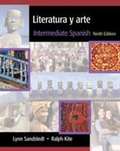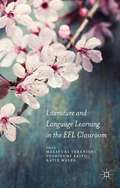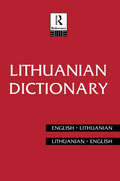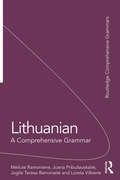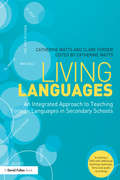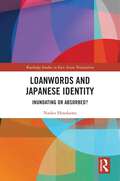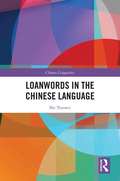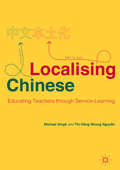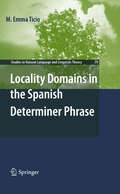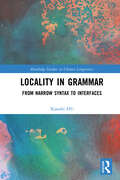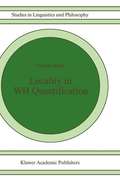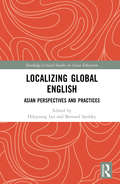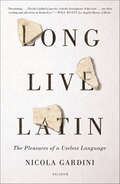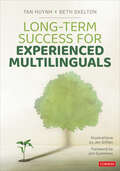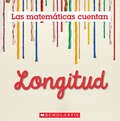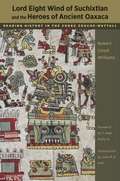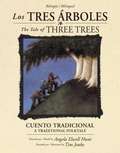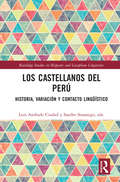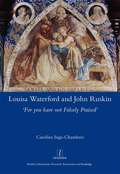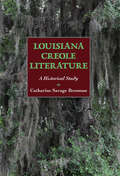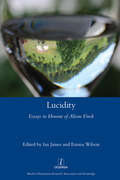- Table View
- List View
Literatura y arte: Intermediate Spanish
by Lynn Sandstedt Ralph KiteThis volume of the series features literary readings as well as artistic masterpieces from the Spanish-speaking world. This volume's 12 units are thematically tied to CONVERSACION Y REPASO. There is better correlation of these supplementary books in marginal annotations on each unit-opening and unit-closing page.
Literature and Language Learning in the EFL Classroom
by Katie Wales Masayuki Teranishi Yoshifumi SaitoThis book examines how literary texts can be incorporated into teaching practices in an EFL classroom. It takes a multi-faceted approach to how English language teaching and learning can best be developed through presentation and exploration of literary texts.
Lithuanian Dictionary: Lithuanian-English, English-Lithuanian (Routledge Bilingual Dictionaries)
by Bronius Piesarskas Bronius SveceviciusAn invaluable resource for linguists, learners and users of Lithuanian, this is the first dictionary of the language generally available in the West for a number of years. Special supplemental section includes a guide to Lithuanian pronunciation and grammar. Over 25,000 entries in each section make this a standard reference.
Lithuanian: A Comprehensive Grammar (Routledge Comprehensive Grammars)
by Meilutė Ramonienė Joana Pribušauskaitė Jogilė Teresa Ramonaitė Loreta VilkienėLithuanian: A Comprehensive Grammar is a complete reference guide to modern Lithuanian grammar. It includes detailed treatment of all grammatical structures and parts of speech, and their semantic and grammatical categories: gender, number, case of nouns, adjectives, numerals and pronouns; degree of comparison of adjectives and adverbs; tense, mood, person, transitivity, aspect and voice of verbs. The morphology chapters describe the formation, inflection and use of the different forms of every part of speech. Under syntax the syntactic relations and types of sentences, the expression of questions and negation, comparison, word order and interpolation are described. All grammatical phenomena are illustrated with examples from the modern language. Descriptions of phonetics and accentuation as well as orthography and punctuation are also included. Lithuanian: A Comprehensive Grammar is an essential reference for learners and users of Lithuanian. It is suitable for independent study and use in schools, colleges, universities and adult classes of all types.
Living Languages: An Integrated Approach to Teaching Foreign Languages in Secondary Schools
by Catherine Watts Clare ForderLiving Languages is simply bursting with practical and original ideas aimed at teachers and trainee teachers of foreign languages in secondary schools. Written by a team of experienced linguists, this book will inspire and motivate the foreign language classroom and the teachers who work within it. Living Languages comprises eight chapters and is structured around the integrated classroom, merging language learning with different aspects of the wider curriculum such as multimedia, theatre and music, celebrations and festivals, sport, and alternative approaches to teaching languages. A DVD is also included with the book containing additional teaching materials and the associated films and audio recordings which make this a fully developed and effective teaching resource. Twenty-eight real-life case studies and projects are presented, all of which have been tried and tested in the classroom with many having won recent educational awards. Ideas and activities outlined in this unique resource include: Languages and multi-media projects involving different uses of technology such as film-making, Digital Storytelling and subtitling in different languages; Languages and theatre and music including the work of the Thêàtre Sans Frontières with its Marie Curie Science Project; Motivating pupils to learn languages whilst keeping fit including examples from Score in French, The German Orienteering Festival and Handball in Spanish; Continuing Professional Development to inspire secondary language teachers to continue their individual professional development. The chapter contains concrete examples of others’ experiences in this area and includes details of support organisations and practical opportunities. Each project is explored from the teachers’ perspective with practical tips, lesson plans and reflections woven throughout the text such as what to budget, how to organise the pre-event period, how to evaluate the activity and whom to contact for further advice in each case. Activities and examples throughout are given in three languages – French, German and Spanish.
Loanwords and Japanese Identity: Inundating or Absorbed? (Routledge Studies In East Asian Translation Ser.)
by Naoko HosokawaLoanwords and Japanese Identity: Inundating or Absorbed? provides an in-depth examination of public discussions on lexical borrowing in the Japanese language. The main objective of this book is to explore the relationship between language and identity through an analysis of public attitudes towards foreign loanwords in contemporary Japanese society. In particular, the book uncovers the process by which language is conceived of as a symbol of national identity by examining an animated newspaper controversy over the use of foreign loanwords. The book concludes that the fierce debate over the use of loanwords can be understood as a particular manifestation of the ongoing (re-)negotiation of Japanese national identity. This book will appeal to scholars and students in sociolinguistics, translation studies, and discourse analysis, while its cultural and geographic focus will attract readers in Japanese studies and East Asian studies.
Loanwords in the Chinese Language (Chinese Linguistics)
by Shi YouweiA loanword, or wailaici, is a word with similar meaning and phonetic form to a word from a foreign language that has been naturalized in the recipient language. From ancient times, cultural exchanges between China and other countries has brought and integrated a myriad of loanwords to the Chinese language. Approaching the topic from a diachronic perspective, this volume is the first book-length work to chart the developmental trajectory, features, functions, and categories of loanwords into Chinese. Beginning with a general introduction to the Chinese loanword system, the author delves deeper to explore trends and standardization in Chinese loanword studies and the research landscape of contemporary loanword studies more generally. Combining theoretical reflections with real-life examples of Chinese loanwords, the author discusses not only long-established examples from the dictionary but also a great number of significant loanwords adopted in the 21st century. The author shows how the complexity of the Chinese loanword system is intertwined with the intricacies of the Chinese character system. This title will be an essential reference for students, scholars, and general readers who are interested in Chinese loanwords, linguistics, and language and culture.
Localising Chinese: Learner-centred, Learning-focused Practices (Palgrave Studies in Teaching and Learning Chinese)
by Michael Singh Thị Hồng Nhung NguyễnThis book presents innovative strategies for teaching the Chinese language to English-speaking students around the world, using in-depth research arising from a long-running and successful Chinese language teaching programme in Sydney. Throughout the book its authors emphasise the importance of teaching methods which explore the relevance of Chinese to all aspects of students’ everyday lives; ‘Localising Chinese’ by folding it into students’ everyday sociolinguistic activities performed in English. The research presented here demonstrates how, through school-driven, research-oriented service-learning, university graduates from China learnt to use student-centred learning-focused language education as a basis for professional learning. In the context of China’s growing influence in the global academic community, this book addresses the urgent need to promote effective communication and partnerships. It provides a valuable resource for language teachers and teacher educators, as well as education researchers in the areas of international education, linguistics, the sociology of education and knowledge exchange.
Locality Domains in the Spanish Determiner Phrase
by M. Emma TicioExamining its subject from a generative perspective, this highly detailed text deals with the syntax of nominal expressions. It focuses on empirical data taken from the Spanish language, though the author goes further to draw conclusions of wider theoretical interest from material culled from other languages too. The book considers crucial phenomena in the nominal domain, such as extraction out of nominal phrases and ellipsis in these phrases, as well as their modification. In doing so it provides the reader with a unified explanation of a number of phenomena that have not previously been analyzed under a single basic account. In particular, Ticio explores how economy notions interact with a number of functional categories, with the length and type of movements allowed, and with the existence of three internal domains within nominal expressions. She uses these observations to inform her analysis of the structure of arguments and adjuncts in nominal expressions, and of the potential these elements have for extraction. To test the empirical adequacy of her analysis, she employs phenomena such as the properties of attributive adjectives, partial cliticization and nominal elision in Spanish nominal phrases.
Locality in Grammar: From Narrow Syntax to Interfaces (Routledge Studies in Chinese Linguistics)
by Xiaoshi HuLocality in Grammar: From Narrow Syntax to Interfaces investigates the operation of locality conditions in syntax and semantics from a cross-linguistic perspective.It is claimed that there are two different types of locality conditions. One is the Generalized Minimality Condition (GMC), and the other is the Phase Impenetrability Condition (PIC). This book demonstrates that these locality conditions play different roles in different computational components of human language, and, therefore, cannot be unified as one constraint as proposed in the literature.The main idea of the book is that the two different locality conditions are sensitive to the difference between syntactic derivation and semantic interpretation and that of overt and covert syntactic derivations. Further investigation shows a more fine-grained distinction must be made between syntactic computations. It is true that GMC does not constrain overt syntactic derivations and PIC does not play a role in semantic interpretations; however, they both regulate covert syntactic computations.This book will inform postgraduate students and scholars in the field of linguistics.
Locality in WH Quantification: Questions and Relative Clauses in Hindi
by Veneeta DayalDayal (linguistics, Rutgers U.) addresses the relation between syntactic structure and semantic representation in the analysis of WH constructions. His main argument is that semantic interpretation is defined on structures that are close to surface syntax, and that the scope domain of a WH expression is the clause in which it occurs at surface structure. While this leaves open issues of interpretation that would otherwise be handled by assigning scope to WH expressions outside the local domain, Dayal argues that intuitions about meaning in these cases are better handled by an enhancement of the semantics used in interpreting WH structures. Annotation c. by Book News, Inc., Portland, OR.
Localizing Global English: Asian Perspectives and Practices (Routledge Critical Studies in Asian Education)
by Hikyoung Lee and Bernard SpolskyEnglish is the most widely taught and learned language in the world and is used for communication among speakers from different language backgrounds. How it can be effectively taught and learned, what English means to, and how it can be "owned" by, non-native speakers of English in Asia and elsewhere, are all issues that warrant contemplation. This edited collection addresses these issues and more by looking at a wide range of topics that are relevant and timely in contexts where English is taught as a foreign language. The authors offer novel perspectives gleaned from theory and actual practice that can inform English language teaching in Asia and beyond. This book will be of interest to researchers, policymakers, curriculum developers, and practitioners in the field of English teaching and learning.
Long Live Latin: The Pleasures of a Useless Language
by Nicola GardiniA “fascinating” meditation on the joys of a not-so-dead language (Los Angeles Review of Books).From acclaimed novelist and Oxford professor Nicola Gardini, this is a personal and passionate look at the Latin language: its history, its authors, its essential role in education, and its enduring impact on modern life—whether we call it “dead” or not.What use is Latin? It’s a question we’re often asked by those who see the language of Cicero as no more than a cumbersome heap of ruins, something to remove from the curriculum. In this sustained meditation, Gardini gives us his sincere and brilliant reply: Latin is, quite simply, the means of expression that made us—and continues to make us—who we are. In Latin, the rigorous and inventive thinker Lucretius examined the nature of our world; the poet Propertius told of love and emotion in a dizzying variety of registers; Caesar affirmed man’s capacity to shape reality through reason; Virgil composed the Aeneid, without which we’d see all of Western history in a different light.In Long Live Latin, Gardini shares his deep love for the language—enriched by his tireless intellectual curiosity—and warmly encourages us to engage with a civilization that has never ceased to exist, because it’s here with us now, whether we know it or not. Thanks to his careful guidance, even without a single lick of Latin grammar, readers can discover how this language is still capable of restoring our sense of identity, with a power that only useless things can miraculously express.“Gardini gives another reason for studying classical languages: ‘The story of our lives is just a fraction of all history . . . life began long before we were born.’ This is the very opposite of a practical argument—it is a meditative, even self-effacing one. To learn a language because it was spoken by some brilliant people 2,000 years ago is to celebrate the world; not a way to optimize yourself, but to get over yourself.” —The Economist“Nicola Gardini’s paean to Latin belongs on the shelf alongside Nabokov’s Lectures on Literature. With a similar blend of erudition, reverence, and impeccable close reading, he connects the dots between etymology and poetry, between syntax and society. And he proves, in the process, that a mysterious and magnificent language, born in ancient Rome, is still relevant to each and every one of us.” —Jhumpa Lahiri, Pulitzer Prize winner and New York Times–bestselling author of Roman Stories
Long-Term Success for Experienced Multilinguals
by Tan Huynh Beth SkeltonAffirm the linguistic, cultural, and experiential assets that multilinguals bring into the classroom. Now is the time to push past the limits of the long-term English learner (LTEL) label and embrace a new way of honoring secondary multilinguals’ valuable life experiences and academic potential. By focusing on experienced multilinguals’ strengths and what teachers can do, you’ll discover new avenues for teaching the academic language skills required for them to process content lessons and clearly communicate discipline-specific ideas. This concise guide presents an easy-to-implement cross-curricular instructional framework specifically designed for secondary content teachers. Practical, research-based, and classroom-tested this book includes: Four essential actions that foster the conditions for experienced multilinguals to reach the highest grade-level content and language proficiency Specific strategies with "try it out" prompts to encourage implementation Templates and anchor charts for structuring lessons Vignettes and stories from both the student and teacher perspective There is nothing lacking with experienced multilinguals. All they need are the right conditions to unlock their potential—so they can express themselves as the mathematicians, scientists, historians, writers, and artists they know themselves to be.
Long-Term Success for Experienced Multilinguals
by Tan Huynh Beth SkeltonAffirm the linguistic, cultural, and experiential assets that multilinguals bring into the classroom. Now is the time to push past the limits of the long-term English learner (LTEL) label and embrace a new way of honoring secondary multilinguals’ valuable life experiences and academic potential. By focusing on experienced multilinguals’ strengths and what teachers can do, you’ll discover new avenues for teaching the academic language skills required for them to process content lessons and clearly communicate discipline-specific ideas. This concise guide presents an easy-to-implement cross-curricular instructional framework specifically designed for secondary content teachers. Practical, research-based, and classroom-tested this book includes: Four essential actions that foster the conditions for experienced multilinguals to reach the highest grade-level content and language proficiency Specific strategies with "try it out" prompts to encourage implementation Templates and anchor charts for structuring lessons Vignettes and stories from both the student and teacher perspective There is nothing lacking with experienced multilinguals. All they need are the right conditions to unlock their potential—so they can express themselves as the mathematicians, scientists, historians, writers, and artists they know themselves to be.
Long-Vowel Shifts in English, c. 1050–1700
by Gjertrud Flermoen StenbrendenThe English language has undergone many sound changes in its long history. Some of these changes had a profound effect on the pronunciation of the language. A number of these significant instances of language evolution are generally grouped together and termed the 'Great Vowel Shift'. These changes are generally considered to be unrelated to other, similar long-vowel changes taking place a little earlier. This book assesses an extensive range of irregular Middle English spellings for all these changes, with a view to identifying the real course of events: the dates, the chronology, and the dialects that stand out as being innovative. Using empirical evidence to offer a fresh perspective and drawing new, convincing conclusions, Stenbrenden offers an interpretation of the history of the English language which may change our view of sound change completely.
Longitud (Math Counts, New and Updated)
by Henry PluckroseAn introduction to length for the youngest readers!Una serie de libros para introducir a los lectores jóvenes a conceptos matemáticos fundamentales, ¡ahora en español!Math Counts series introduces young readers (grades K-3) to early math concepts. Real-world examples and corresponding photos make math concepts easy to grasp.We use the word length to describe the measurement of something from one end to the other.Usamos la palabra longitud para describir la medida de algo de un extremo al otro. Pies, pulgadas, metros, millas y kilómetros se utilizan para medir la longitud. Con ejemplos de la vida real, fotografías convincentes y textos inspiradores, ¡esta es la introducción perfecta al concepto matemático de "longitud" para los lectores más jóvenes!Sobre la Serie:Publicada originalmente en los años 90 y actualizada recientemente, esta revolucionaria serie superventas inicia a los niños en el camino de aprender a comunicarse y razonar matemáticamente.La base de las matemáticas son las ideas, y estos libros se han desarrollado para que los niños vean, hablen, toquen y experimenten con estas ideas. Las fotografías atractivas y el texto sencillo y directo hacen de esta serie una herramienta perfecta para leer individualmente o en voz alta. Diez conceptos matemáticos fundamentales, uno para cada libro de la serie, están desarrollados de forma excelente, y ofrecen un apoyo curricular ideal. Esta serie es la mejor manera de iniciar el camino hacia el dominio de las matemáticas.
Lord Eight Wind of Suchixtlan and the Heroes of Ancient Oaxaca
by Robert Lloyd WilliamsIn the pre-Hispanic Mesoamerican world, histories and collections of ritual knowledge were often presented in the form of painted and folded books now known as codices, and the knowledge itself was encoded into pictographs. Eight codices have survived from the Mixtec peoples of ancient Oaxaca, Mexico; a part of one of them, the Codex Zouche-Nuttall, is the subject of this book. As a group, the Mixtec codices contain the longest detailed histories and royal genealogies known for any indigenous people in the western hemisphere. The Codex Zouche-Nuttall offers a unique window into how the Mixtecs themselves viewed their social and political cosmos without the bias of western European interpretation. At the same time, however, the complex calendrical information recorded in the Zouche-Nuttall has made it resistant to historical, chronological analysis, thereby rendering its narrative obscure. In this pathfinding work, Robert Lloyd Williams presents a methodology for reading the Codex Zouche-Nuttall that unlocks its essentially linear historical chronology. Recognizing that the codex is a combination of history in the European sense and the timelessness of myth in the Native American sense, he brings to vivid life the history of Lord Eight Wind of Suchixtlan (AD 935–1027), a ruler with the attributes of both man and deity, as well as other heroic Oaxacan figures. Williams also provides context for the history of Lord Eight Wind through essays dealing with Mixtec ceremonial rites and social structure, drawn from information in five surviving Mixtec codices.
Los Niños Alfabéticos
by Lourdes Ayala Margarita Isona-Rodriguez Kathryn ShoemakerWelcome to an alphabet adventure you'll never forget! Join Gerardo, Isabel, and their friends as they act out the letters of the Spanish alphabet using imaginative props and colorful costumes. Letter sounds are reinforced throughout each playful skit. The bright color illustrations are engaging and filled with many surprises. Watch closely as the fun begins!
Los Tres Árboles / The Tale of Three Trees (Bilingüe / Bilingual)
by Angela Elwell HuntHabía una vez, encima cíe una montaña tres arbolitos que SOÑABAN con lo que querían ser cuando se hicieran grandes. Así empieza este lindo cuento tradicional americano que relata cómo los, deseos de tres árboles se hacen realidad de una manera sorprendente. Lectores de todas edades se deleitarán de esta narración encantadora por Angela Elwell Hunt. Es una historia para la Navidad, la Pascua y todo el A año. Las ilustraciones luminosas de Tim Jonke agregan a este cuento clásico un sentido de profundidad y asombro. Once upon a mountaintop, three little trees stood and DREAMED of what they wanted to become when they grew up... So begins this enchanting American folktale about three trees whose wishes come true in a surprising way. Readers of all ages will be delighted by Angela Elwell Hunt's retelling of the timeless tale-a story for Christmas, Easter, and all year round. Tim Jonke's luminous paintings give this classic story an added sense of depth and wonder.
Los castellanos del Perú: historia, variación y contacto lingüístico (Routledge Studies in Hispanic and Lusophone Linguistics)
by Luis Andrade Ciudad y Sandro Sessarego, eds.Este libro reúne contribuciones de destacados investigadores de la lingüística hispánica para ofrecer un panorama integral de los castellanos del Perú, incluidos algunos que han sido tradicionalmente objeto de discriminación, como el castellano andino, el amazónico y el afroperuano. Los capítulos se concentran en diferentes variedades habladas en el Perú desde distintos enfoques teóricos y metodológicos, atendiendo a su formación, su contexto social e histórico y los fenómenos de contacto que las caracterizan. De este modo, aunque el volumen tiene un foco regional muy específico, los problemas que aborda son de interés y relevancia para el estudio de otras variedades del español, para el tratamiento de otros problemas derivados del contacto lingüístico y para la dialectología e historia de los castellanos latinoamericanos en general. Escrito en castellano, este volumen será de interés para estudiantes graduados en lingüística hispánica e investigadores dedicados a la dialectología, la sociolingüística y la lingüística del contacto.
Louisa Waterford and John Ruskin: 'For You Have Not Falsely Praised'
by Caroline Ings-ChambersLouisa Waterford (1818-91), modest, retiring, of good family, renowned for her beauty, and with extraordinary grace, was the embodiment of a Victorian ideal of womanhood. But like the age itself, her life was filled with contrasts and paradoxes. She had been born with artistic gifts, and became a satellite of the Pre-Raphaelite Brotherhood, though she had no formal training. Then, at the height of John Ruskin's intellectual power and success as a critic, she asked him to accept her as an art student, and he accepted. Their correspondence- often harshly critical, never, as Waterford put it, falsely praising - lies at the heart of this book. These are letters which open a spectrum of discussion on the cultural, gender and social issues of the period. Both Waterford and Ruskin engaged in tireless philanthropic work for diverse causes, crossing social boundaries with subtle determination, and both responded to a sense of duty as well as an artistic vocation. But, as Ings-Chambers shows, their correspondence was more than a dialogue about society: it helped to make Waterford the artist she became.
Louisiana Creole Literature: A Historical Study
by Catharine Savage BrosmanLouisiana Creole Literature is a broad-ranging critical reading of belles lettres—in both French and English—connected to and generally produced by the distinctive Louisiana Creole peoples, chiefly in the southeastern part of the state. The book covers primarily the nineteenth and twentieth centuries, the flourishing period during which the term Creole had broad and contested cultural reference in Louisiana. The study consists in part of literary history and biography. When available and appropriate, each discussion—arranged chronologically—provides pertinent personal information on authors, as well as publishing facts. Readers will find also summaries and evaluation of key texts, some virtually unknown, others of difficult access. Brosman illuminates the biographies and works of Kate Chopin, Lafcadio Hearn, George Washington Cable, Grace King, and Adolphe Duhart, among others. In addition, she challenges views that appear to be skewed regarding canon formation. The book places emphasis on poetry and fiction, reaching from early nineteenth-century writing through the twentieth century to selected works by poets still writing in the early twenty-first century. A few plays are treated also, especially by Victor Séjour. Louisiana Creole Literature examines at length the writings of important Francophone figures, and certain Anglophone novelists likewise receive extended treatment. Since much of nineteenth-century Louisiana literature was transnational, the book considers Creole-based works which appeared in Paris as well as those published locally.
Lucidity: Essays in Honour of Alison Finch (Legenda)
by Ian James and Emma WilsonThis collection of essays addresses the question of lucidity as a thematic in literature and film but also as a quality of both expression and insight in literary criticism and critical thought more generally. The essays offer treatments of lucidity in itself and in relation to its opposites, forms of obscurity and darkness. They offer attention to problems of philosophical thought and reason, to questions of literary and poetic form, and of photographic and filmic contemplation. Ranging from engagements with early modern writing through to more recent material the contributions focus in particular on nineteenth- and twentieth-century French prose and poetry, the field which has been the predominant focus of Alison Finch’s critical writing. They are written as tributes to the distinctively lucid insights of her work and to the breadth and clarity of its intellectual engagement.
Lupita's First Dance
by Gabriela Baeza Ventura Lupe Ruiz-Flores Gabhor UtomoLupita is excited about dancing la raspa, a Mexican folk dance, with her first-grade class at a celebration of Childrens Day. But she's devastated when she learns right before the show that her partner Ernesto sprained his right ankle. She had been practicing for weeks. And now her family won't get to see her, swishing and swaying in her beautiful dress full of colorful ribbons.
